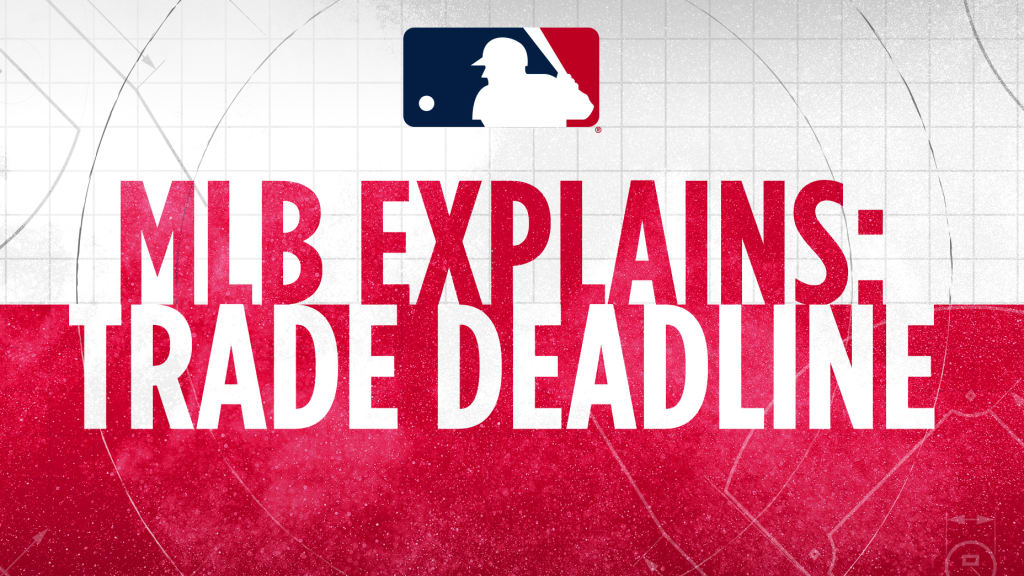
The term “deadline” implies a certain sense of finality, a defining line that can’t be crossed.
But for decades, baseball’s Trade Deadline wasn’t exactly a deadline. After it passed, there was still ample opportunity for clubs to improve their rosters with external additions in the trade market. (Remember when Dallas Keuchel publicly complained about the 2017 Astros’ quiet July 31 Deadline activity, and they wound up landing Justin Verlander a month later?)
That all changed in 2019 (something you may have forgotten because of the pandemic-shortened 2020 season). There is now one, true Trade Deadline.
Because the elimination of the August waiver trade period might be as difficult for some fans to grasp as the mere existence of the August waiver trading period was difficult for other fans to grasp -- and because the strange 2020 season and its Aug. 31 Trade Deadline was difficult for everybody to grasp -- here’s a handy FAQ that should help all fans understand what the true Trade Deadline entails.
When is the Trade Deadline?
The Deadline for 2021 is at 4 p.m. ET on July 30.
Why not July 31?
With July 31 falling on a Saturday that includes several day games this season, the Trade Deadline was moved up one day. But most years, it will be July 31.
What is the meaning of a “true” Trade Deadline?
The Trade Deadline is, indeed, a deadline. No players will change hands via trade after that date.
How is this different from years prior to 2019?
Prior to 2019, a player could be traded after the July Trade Deadline under one of two conditions.
- He first cleared revocable trade waivers.
- Or if the club claiming the player on waivers worked out a trade with the team that placed the player on waivers.
As long as players were acquired by Aug. 31, they were eligible to play for their new clubs in the postseason.
The August waiver period had a profound impact on playoff races over the years. The Blue Jays acquired David Cone from the Mets after he cleared waivers in 1992, and he helped pitch them to their first World Series title. In 2004, the Cardinals worked out a trade for Larry Walker, who had cleared waivers, and he helped them reach the Fall Classic. And the Astros’ acquisition of Verlander after he cleared waivers was the turning point in their bid for their first World Series championship.
Even beyond what it meant to various playoff races, the August trade period had a big effect on baseball history, such as John Smoltz going from Detroit to Atlanta, Jeff Bagwell going from Boston to Houston, Jose Bautista going from Pittsburgh to Toronto and the Dodgers and Red Sox working out a 2012 deal in which more than a quarter of a billion dollars’ worth of contracts -- including those of Josh Beckett, Carl Crawford, and Adrian Gonzalez -- changed hands.
So can players still be placed on waivers after July 31?
Yes, players can still be placed on outright waivers and claimed by other clubs, but it has to be a straight waiver claim, meaning the new team takes on the player’s remaining contract and no other players are involved.
Sometimes veteran players on costly contracts are placed on waivers in the hope of shedding salary, so it’s possible you might see some high-priced players switch teams on waivers this August for that reason alone.
Are players acquired via waivers after July 30 still eligible for postseason rosters?
Yes. But the Aug. 31 postseason roster deadline still applies. If you are not in the organization before September, you cannot appear in the postseason for them.
What are the effects of the “true” Trade Deadline?
It has only been in effect for a relatively short time, but already we’ve seen some interesting action under the “true” Trade Deadline. In 2019, there were a whopping 25 trades made in the last two business days before the Deadline, punctuated by the Astros’ stunning acquisition of D-backs ace Zack Greinke right at the buzzer. And while 2020 was an unusually short season, its Trade Deadline still had ample activity, with 17 deals made on Deadline day alone.
So it seems safe to suggest that eliminating the waiver trade period is pushing teams to act while they still can. They must make calculated assessments of their roster strengths and weaknesses -- and their overall ability to contend for a title -- earlier than they once did, and deadlines, by their very nature, compel action.
It behooves contenders to identify and address areas of need as early in the season as possible and for teams potentially situated as sellers to market their assets early, as well. Teams that wait too long to sell could find themselves swallowing a good bit of salary near the Deadline, because quite often it was the players on contracts that outpaced their production who cleared waivers and were moved in August.
What about Minor League trades?
Veteran players on Minor League contracts (in other words, not on a 40-man roster) could see their values to contending clubs increase as injuries or other unforeseen circumstances develop after the Deadline. The key distinction is that it’s a player on a Minor League contract.
Anything else to know?
This isn’t new, but it’s worth reminding people that if you are an impending free agent who is traded during the season, the team that acquires you cannot give you a qualifying offer and therefore receive Draft pick compensation if you sign elsewhere. That means that when a team is trying to calculate its trade return for an impending free agent, it must try to determine if the prospect (or prospects) it is getting in return carry more value than the Draft pick and the associated Draft bonus pool money it would get if they give that player a qualifying offer in the offseason and he signs elsewhere.


